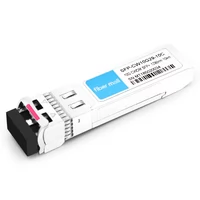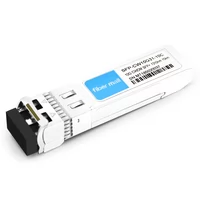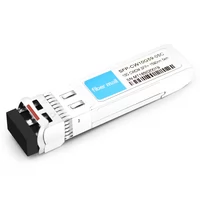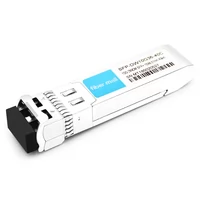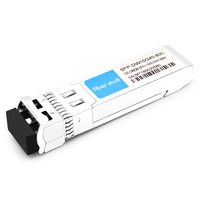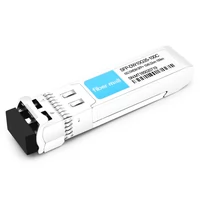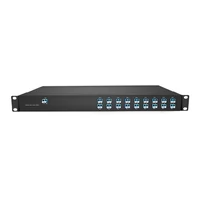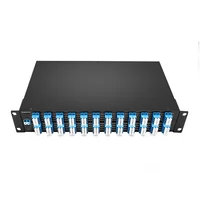Table of Contents
ToggleThe Basic Components of the WDM System
WDM, wavelength division multiplexing, is a relatively advanced fiber optic communication technology. It is the technology of data transmission by converging multiple optical signals of different wavelengths and rates in different optical channels through a combiner and coupling them into the same optical fiber. The digital signals carried by these different wavelengths can be the same rate, the same format, or different rates and different data formats.
The basic composition of the WDM system is mainly divided into two ways: two-fiber unidirectional transmission and single-fiber bidirectional transmission. Unidirectional WDM means that all optical paths are transmitted simultaneously in the same direction on a single fiber. At the transmitter side, the tuned optical signals with different wavelengths containing various information are combined together through an optical extender and transmitted in one fiber in one direction. Since each signal is carried by different wavelengths of light, they are not mixed up with each other. At the receiving end, optical signals of different wavelengths are separated by optical multiplexers to complete the transmission of multiple optical signals, while the opposite direction is transmitted through another optical fiber.
Bidirectional WDM means that the optical path is transmitted in two different directions on one fiber at the same time, and the wavelengths used are separated from each other to achieve full-duplex communication between the two sides.
WDM system generally consists of four parts: optical transmitter, optical relay amplifier, optical receiver, and optical supervisory channel.
In the whole WDM system, the optical wavelength division multiplexer and demultiplexer are the key components in WDM technology, and their performance is decisive for the transmission quality of the system. The device that combines the signals of different light source wavelengths together through a transmission fiber output is called a multiplexer.
On the contrary, the device that splits the multi-wavelength signal from the same transmission fiber into individual wavelengths is called a demultiplexer. In principle, the device is reversible in both directions, that is, as long as the output and input of the demultiplexer are reversed, it is a multiplexer. Optical wavelength division multiplexer performance indicators are mainly access loss and crosstalk, requiring loss and frequency bias to be small, access loss should be less than 1.0 ~ 2.5db, crosstalk between channels is small, isolation is large, and the impact between different wavelength signals is small.
How does Wavelength Division Multiplexing(WDM) Work?

Working principle of WDM
Wavelength x frequency = speed of light (constant value), so WDM is actually the same with frequency division multiplexing.
To put it simply, we can think of WDM as a highway——where different types of vehicles rush in and then go their separate ways when they get to their destination.

The role of wavelength division multiplexing is to improve the transmission capacity of optical fiber and the utilization efficiency of optical fiber resources. For the WDM system, to make it work normally, it is obvious that the wavelength (frequency) of each optical signal must be controlled. If the wavelength interval is too short, it is easy to “crash”; If the wavelength interval is too long, the utilization rate will be very low.

WDM technology is very important for network expansion and upgrading, developing broadband services, tapping fiber bandwidth capacity, and realizing ultra-high-speed communication.
The Advantages of WDM Technology
WDM technology has been developing rapidly in recent years because of the following advantages.
(1) Large transmission capacity, which can save valuable fiber resources. For a single-wavelength fiber system, a pair of fibers is needed to send and receive a signal, while for a WDM system, only one pair of fibers is needed for the entire multiplexing system, regardless of the number of signals. For example, for a sixteen 2.5Gb/s system, a single-wavelength fiber system requires 32 fibers, while a WDM system requires only two fibers.
(2) Transparent to all kinds of service signals, it can transmit different types of signals, such as digital signals, and analog signals, and can synthesize and decompose them.
(3) There is no need to lay more optical fibers or use high-speed network components during network expansion. Any new services can be introduced or capacity can be expanded only by changing the terminal and adding an additional optical wavelength. Therefore, WDM technology is an ideal means of expansion.
(4) Build a dynamically reconfigurable optical network, and use optical add-drop multiplexers (OADM) or optical cross-connect equipment (OXC) at network nodes to form a highly flexible, highly reliable, and highly survivable all-optical network.
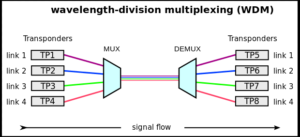
the WDM system
Problems Existing in WDM Technology
The optical transmission network based on WDM technology, with an add-drop multiplexing function and cross-connect function, has great advantages such as easy reconfiguration and good scalability. It has become the development trend of the high-speed transmission network in the future. But before it can be realized, the following problems must be solved.
-
Network Management
At present, the network management of the WDM system, especially that with complex up/down path requirements, is still immature. If the WDM system cannot carry out effective network management, it will be difficult to adopt on a large scale in the network. For example, in terms of fault management, since the WDM system can support different types of service signals on the optical channel, once the WDM system fails, the operating system should be able to detect the fault in time and find out the cause of the fault.
But so far, the relevant operation and maintenance software are still immature. In terms of performance management, WDM systems use analog methods to multiplex and amplify optical signals, so the commonly used bit error rate is not suitable for measuring the quality of WDM services. A new parameter must be found to accurately measure the quality of service provided by the network to users. If these problems are not solved in time, they will hinder the development of the WDM system.
-
Interconnection and Intercommunication
Since WDM is a new technology, its industry standard is relatively rough, so the interoperability of WDM products in different businesses is poor, especially in the aspect of upper-layer network management. In order to ensure the large-scale implementation of WDM systems in the network, it is necessary to ensure the interoperability between WDM systems and the interconnection and intercommunication between WDM systems and traditional systems. Therefore, the research on optical interface equipment should be strengthened.
-
Optical Device
The immaturity of some important optical devices such as tunable lasers will directly limit the development of optical transmission networks. For some large operating companies, it is already very tricky to deal with several different lasers in the network, let alone dozens of optical signals. In most cases, 4 to 6 lasers that can be tuned in the entire network are required to be used in an optical network, but such tunable lasers are not yet commercially available.
The design of the communication system is different, and the spacing width between each wavelength is also different. According to the different channel spacing, WDM can be subdivided into CWDM (coarse wavelength division multiplexing) and DWDM (dense wavelength division multiplexing). The channel spacing of CWDM is 20nm, while the channel spacing of DWDM is from 0.2nm to 1.2nm.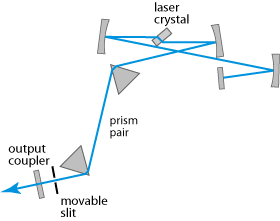
setup of a tunable laser
CWDM vs DWDM
At first, the technical conditions were limited, and the wavelength spacing would be controlled within tens of nanometers. This type of WDM is called Coarse Wavelength Division Multiplexing(CWDM).
Later, the technology became more and more advanced, and the wavelength interval became shorter and shorter. It was called Dense Wavelength Division Multiplexing(DWDM) when it reached a level within a few nanometers.
In addition, CWDM-modulated lasers use uncooled lasers, while DWDMs use cooled lasers. Cooled lasers are temperature tuned and uncooled lasers are electronically tuned. It is difficult and expensive to implement temperature tuning because the temperature distribution is highly non-uniform over a wide range of wavelengths. CWDM avoids this difficulty and thus greatly reduces the cost. The cost of the entire CWDM system is only 30% of that of DWDM. CWDM is achieved by combining wavelengths transmitted in different fibers into one fiber for transmission using an optical multiplexer. At the receiving end of the link, the demultiplexer is used to send the decomposed wavelengths to different fibers and then to different receivers.
CWDM has a wavelength spacing of 20nm and 18 wavebands from 1270nm to 1610nm.
| Wavelength Number | Central Wavelength | Wavelength Number | Central Wavelength |
| 1 | 1471 | 10 | 1291 |
| 2 | 1491 | 11 | 1311 |
| 3 | 1511 | 12 | 1331 |
| 4 | 1531 | 13 | 1351 |
| 5 | 1551 | 14 | 1371 |
| 6 | 1571 | 15 | 1391 |
| 7 | 1591 | 16 | 1411 |
| 8 | 1611 | 17 | 1431 |
| 9 | 1271 | 18 | 1451 |
However, due to the obvious attenuation increase in the wavebands from 1270nm to 1470nm, many old-type optical fibers cannot be used normally, so CWDM generally gives priority to the use of the 8 wavebands from 1470nm to 1610nm.

CWDM to DWDM
The wavelength spacing of DWDM can be 1.6nm, 0.8nm, 0.4nm, and 0.2nm, which can accommodate 40/80/160 waves (up to 192 waves). The wave range of DWDM is 1525nm to 1565nm (C band) and 1570nm to 1610nm (L band).

CWDM to DWDM
DWDM is commonly used in C-band, with a wavelength interval of 0.4nm and a channel frequency interval of 50GHz.
Other differences Between CWDM and DWDM
-
CWDM has a simpler structure
CWDM system does not contain OLA, namely Optical Line Amplifier. In addition, since the CWDM channel spacing is relatively large, there is no need to consider power balancing compared to DWDM.
-
CWDM consumes less power
The operating cost of an optical transmission system depends on the maintenance of the system and the power consumed by the system. Even if the maintenance costs of both DWDM and CWDM systems are acceptable, the power consumption of a DWDM system is much higher than that of a CWDM system. In DWDM systems, with the increase in the total number of multiplexed wavelengths and single-channel transmission rates, power loss and temperature management have become key issues in circuit board design. Lasers without coolers are used in CWDM systems, resulting in low system power consumption, which is beneficial for system operators to save money.
-
CWDM devices have smaller physical size
CWDM lasers are much smaller than DWDM lasers, and uncooled lasers generally consist of a laser sheet and a monitoring photodiode sealed in a metal container with a glass window. The size of the DWDM laser transmitter is about five times the volume of the CWDM laser transmitter. That is, if the volume of the DWDM laser transmitter is 100cm3, the volume of the CWDM laser without the cooler is only 20cm3.
-
CWDM has lower requirements on the transmission medium
When DWDM runs services above 10G, G.655 optical fibers are required. However, CWDM has no special requirements for optical fiber. G.652, G.653, and G.655 optical fibers can use CWDM technology, so they can make a lot of use of the old fiber optic cable previously laid.
-
Comparison of application environments
Most of the DWDM suitable for metro networks inherit the characteristics of long-haul backbone networks, such as end-to-end logical connections, inflexible topology, no support for mesh structure, and no adaptation to the complex and mobile multi-logical topology in metro networks. The cost of DWDM equipment for a long-haul backbone network is much lower than the cost of laying new fibers and adding optical amplification. However, within the scope of the metropolitan area network, the network cost mainly comes from the cost of the access end equipment rather than the cost of the transmission line, so DWDM does not have a great advantage in terms of price. CWDM realizes wavelength division multiplexing in the full wavelength range (1260-1620nm) by reducing the window requirements for wavelengths. It also greatly reduces the cost of optical devices and can achieve a higher cost performance within 0-80km.
A summary comparison of CWDM and DWDM
CWDM DWDM
Full Name Coarse Wavelength Division Multiplexing Dense Wavelength Division Multiplexing
Wave Interval 20nm in general 0.8nm/0.4nm/0.2nm/1.6nm
Wave Range 1270nm to 1610nm 1525nm to 1565nm (C band)
1570nm to 1610nm (L band)
Numbers of Wavebands 18 40/80/160 (up to 192)
Optical Modulation Form Uncooled laser, electronically tuned Cooled laser, tuned by temperature
Cost Low High
Communication Distance Short (Optical amplifiers unsupported) Long
Structure Simple Complex
Power consumption Low High
Physical size Small Big
Requirement for transmission medium Low High
MWDM vs LWDM
Nowadays, the 5G network is blooming. When the Communications Service Providers (CSP) build a 5G fronthaul network, they always fall into a dilemma: if they choose the more active WDM with higher operation and maintenance efficiency, the cost will increase; If we choose the low-cost passive WDM mode, it is difficult to improve the operation and maintenance efficiency, and it can not match the business needs in the future. Therefore, CSPs hope to find a way to deploy a 5G fronthaul network to realize both cost and operation efficiency. In this case, open WDM was born.

Application of 5G fronthaul network
The principle of MWDM(Medium Wavelength Division Multiplexing), is to focus on using the first 6 waves of 25G CWDM, by adding TEC (Thermal Electronic Cooler) for temperature control, then left and right offset 3.5nm wavelengths to form 12 wavelengths, this solution can save a lot of fiber resources.
The pilot of the MWDM semi-active 5G fronthaul solution on the existing network strongly supports the maturity of MWDM technology and will accelerate the commercialization of the semi-active 5G fronthaul solution.
All 5G fronthaul requires at least 12 wavelength channels, so the solutions of three major operators, all aim to achieve 12 waves.
By adding TEC (Thermal Electronic Cooler) temperature control, the left and right wavelengths are shifted by 3.5nm to form 12 wavelengths.
This solution not only reuses the CWDM industry chain, but also can meet CMCC’s own demand of 10km fronthaul distance, and saves a lot of fiber resources, which is a multi-benefit.

MWDM:6 wavelengths increase to 12 wavelengths
Then about LWDM(Lan Wavelength Division Multiplexing), LWDM is Ethernet channel-based wavelength division multiplexing (LAN WDM), with a channel spacing of 200 to 800 GHz, a range between DWDM (100 GHz, 50 GHz) and CWDM (about 3 THz).
Wavelength Application Scheme Industrial chain
1269.23 DWL+PIN /
1273.54 DWL+PIN Share 400G LR8 industry chain
1277.89 DWL+PIN
1282.26 DWL+PIN
1286.66 DWL+PIN
1291.1 DWL+PIN /
1295.56 DWL+PIN Share 400G LR4 industry chain
1300.05 DWL+PIN
1304.58 DWL+PIN
1309.14 DWL+PIN
1313.73 DWL+PIN /
1318.35 DWL+PIN /
DML (Directly Modulated Laser) is at the transmitting end(TOSA) of the optical module, and its counterpart is the EML (Electro-absorption Modulated Laser), which is more costly. And PIN refers to the light-emitting diode at the receiving end(ROSA) of the optical module.

The internal structure of an optical module
Application Scenario
5G fronthaul is dominated by 25G Regular optical wavelengths, China Mobile’s statement at the Optical Expo in September 2019: We believe that in the CRAN scenario, 25GBiDi is mainly used where there are fiber resources, and the WDM solution is mainly used where there are no fiber resources.
In the case of the semi-active, a single station also has 12 optical modules: we believe that the semi-active A type (24 optical modules) is more expensive and is not used in the current network, the current network of MWDM semi-active is used B type, only 12 optical modules.
Mobile frequency expansion, and telecom sharing (China Telecom and China Unicom share a 5G network) bring single station 12 optical modules demand, CWDM needs to be expanded to 12 waves.
The mobile 2.6GHz spectrum is expanded to 160MHz, and the telecom sharing is expanded to 200MHz, so for the 64TRX station type, single station needs 12 optical modules. 64TRX station type, the 12-wave solution is expected to become mainstream, and this station type is expected to account for 50% in the long run.
MWDM solution is more costly, because it has the support of China Mobile, so it will be supported by the industry chain, while LWDM from the maturity of the industry chain, cost, and power consumption is more advantageous compared to MWDM, or will become the main solution for the subsequent 12-wave construction.
Summary
Fiber mall focuses on providing optical communication solutions for customers, including design, R&D, manufacturing, and one-stop customized production. The main products are optical transceivers, DAC&AOC cables, OTN equipment, optical fiber connector, PLC splitter, WDM, optical fiber network cards, etc. The products are widely used in FTTH, Data centers, 5G networks, and telecommunication networks.
Related Products:
-
 SFP-CW10G29-10C 10G CWDM SFP+ 1290nm 10km LC SMF DDM Transceiver Module
$60.00
SFP-CW10G29-10C 10G CWDM SFP+ 1290nm 10km LC SMF DDM Transceiver Module
$60.00
-
 SFP-CW10G31-10C 10G CWDM SFP+ 1310nm 10km LC SMF DDM Transceiver Module
$60.00
SFP-CW10G31-10C 10G CWDM SFP+ 1310nm 10km LC SMF DDM Transceiver Module
$60.00
-
 SFP-CW10G59-05C 10G CWDM SFP+ 1590nm 5km LC SMF DDM Transceiver Module
$60.00
SFP-CW10G59-05C 10G CWDM SFP+ 1590nm 5km LC SMF DDM Transceiver Module
$60.00
-
 SFP-DW10G36-40C 10G DWDM SFP+ C36 100GHz 1548.51nm 40km LC SMF DDM Transceiver Module
$155.00
SFP-DW10G36-40C 10G DWDM SFP+ C36 100GHz 1548.51nm 40km LC SMF DDM Transceiver Module
$155.00
-
 SFP-DW10G40-80C 10G DWDM SFP+ C40 100GHz 1545.32nm 80km LC SMF DDM Transceiver Module
$175.00
SFP-DW10G40-80C 10G DWDM SFP+ C40 100GHz 1545.32nm 80km LC SMF DDM Transceiver Module
$175.00
-
 SFP-DW10G35-100C 10G DWDM SFP+ C35 100GHz 1549.32nm 100km LC SMF DDM Transceiver Module
$235.00
SFP-DW10G35-100C 10G DWDM SFP+ C35 100GHz 1549.32nm 100km LC SMF DDM Transceiver Module
$235.00
-
 Passive CWDM Double Fiber Mux & Demux Module 18 CH (1270-1610nm) LC/UPC 1U Rack
$630.00
Passive CWDM Double Fiber Mux & Demux Module 18 CH (1270-1610nm) LC/UPC 1U Rack
$630.00
-
 DWDM MUX DEMUX 50GHZ 96CH (C15-C62) LC/UPC Dual Fiber 2U Rack
$6000.00
DWDM MUX DEMUX 50GHZ 96CH (C15-C62) LC/UPC Dual Fiber 2U Rack
$6000.00

